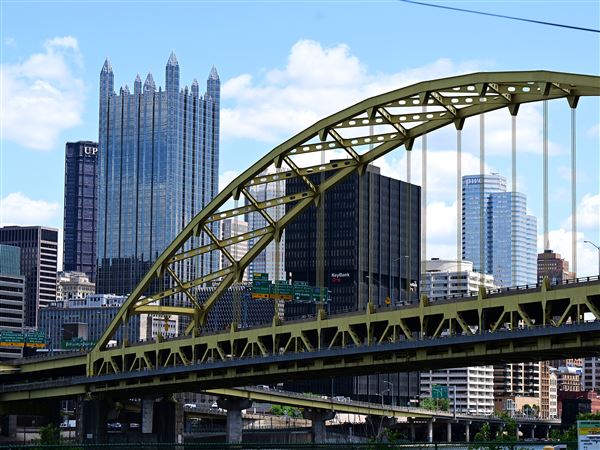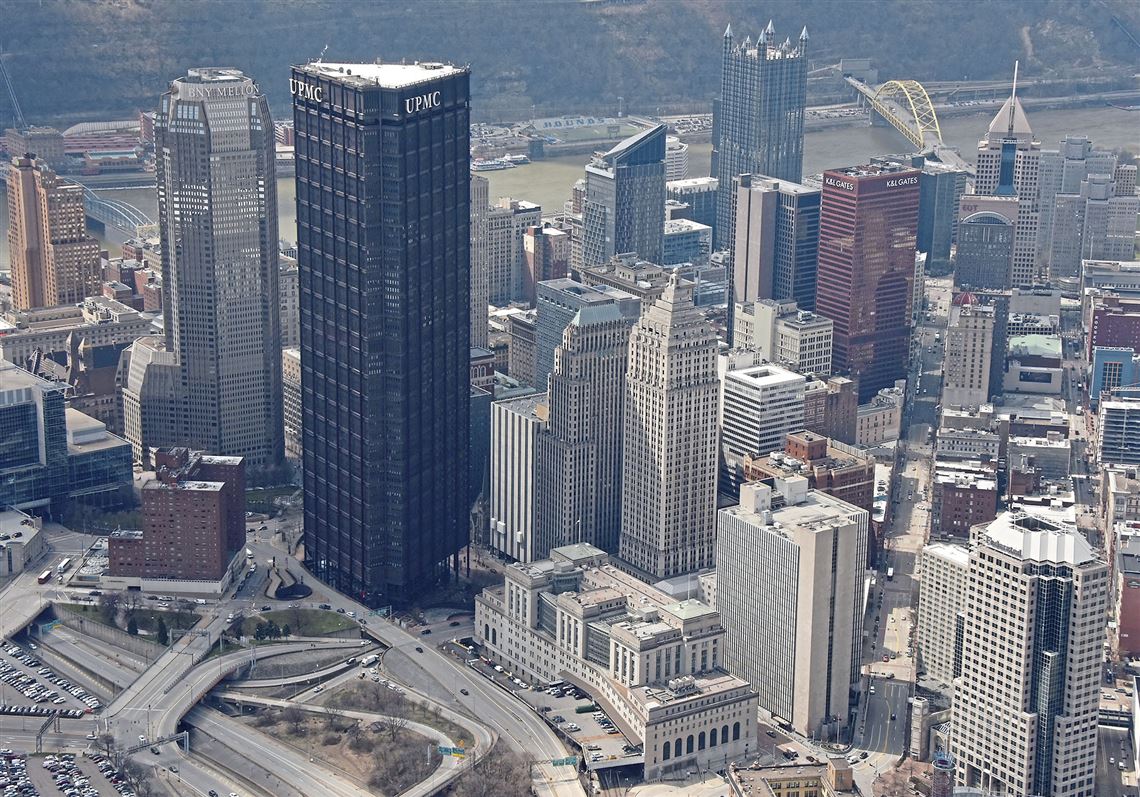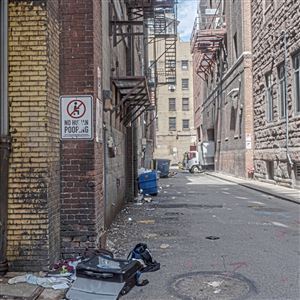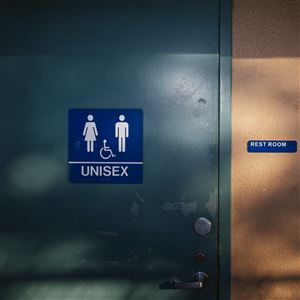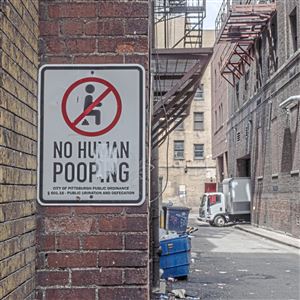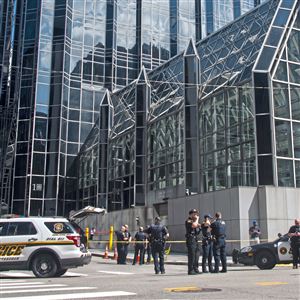Public restrooms are being installed Downtown as part of at least $2 million in spending aimed at curbing concerns about cleanliness, lewd behavior and other safety-related issues plaguing the city’s core.
The announcement came at a press conference Wednesday during which the Allegheny Conference on Community Development and other stakeholders, including Mayor Ed Gainey, unveiled IndexPGH, a website to chart the Golden Triangle’s health on issues such as crime, visits, real estate and cleanliness.
Public urination and defecation have been a major issue for some time, with businesses, residents and visitors complaining about people using alleyways and even sidewalks to do their business. The six-month pilot project for the installation of three trailer-like public restrooms is designed to address that.
It will start next month, at locations to be determined. The facilities will be open and staffed from 7 a.m to 11 p.m. daily and equipped with running water, heat and air conditioning.
“This is really an effort to get these on the street while we work with the city on building out more permanent facilities,” said Jeremy Waldrup, president and CEO of the Pittsburgh Downtown Partnership. “This is something we’ve heard countless times of the need from everyone coming into Downtown.”
While the precise spots have yet to be identified, Mr. Waldrup said they would be in high traffic areas. “We want them to be very visible and utilized.”
Mr. Gainey, who has been dogged by complaints that he isn’t doing enough to address issues like crime, safety, homelessness, and open drug dealing in the Golden Triangle, acknowledged that Pittsburgh is behind other cities in offering public restrooms.
“We’re late to the game but that doesn’t mean we can’t catch up,” he said. “We need public restrooms Downtown and we need to ensure that we’re doing everything to keep it safe.”
Twice over the past year, including last week, a team from Point Park University has called for public restrooms Downtown in separate studies.
It has said such facilities not only would help the homeless and address issues like public urination and the “smell of stale urine and excrement” in alleyways but also would be a service to those who come Downtown for shows and other events.
Last year’s study recommended restrooms in high traffic areas such as Market Square, the Cultural District, transit hubs and Mellon Square. Among the types it considered was a mobile trailer equipped with heat and air conditioning.
Heather Starr Fiedler, chair of Point Park’s department of community engagement and leadership who led the study on public restrooms, called the pilot program “very exciting.”
“Even as a pilot, I think it’s a wonderful move, a first step in revitalizing Downtown,” she said, adding that a “clean and safe place to use a restroom should be a right, not a privilege.”
A Point Park team in the community engagement doctorate program again called for public restrooms in a study released last week examining Downtown alleys. Ms. Fiedler said the group decided to make the recommendation after being surprised by how frequently people were using alleys to relieve themselves.
“When people are using alleys to go to the bathroom, I think that’s a real signal that we need some public restrooms,” she said.
Ms. Fiedler recommended high traffic spots like transit hubs, Market Square, and bridges leading to the North Shore stadiums for restrooms. She saw the trailer set-up as a smart move, similar to what Denver has been doing.
Mr. Gainey said officials are considering locations where the restrooms don’t “infringe on business” but are visible enough for people to find them.
“I think we have to be able to be flexible and take a look at it so temporary can turn to permanent,” he said. “But let us be able to start first and be able to evaluate which direction we need to go.”
The Allegheny Conference convened corporate and philanthropic partners to raise at least $2 million for the public restrooms and other initiatives. Funds also will be used to expand the Pittsburgh Downtown Partnership clean team, improve health outreach efforts, increase programming in Market and Mellon squares, and enhance public realm lighting.
Stefani Pashman, Allegheny Conference CEO, said the money will be available immediately to help with the efforts, all targeted at improving safety and cleanliness in the central business district.
Mr. Waldrup said the PDP plans to expand its clean team to operate 24/7 instead of its current schedule of 6 a.m. to 11 p.m. Weekend service also will increase significantly.
Longer term, the conference is working with other stakeholders on a vision “that reimagines Downtown, the Downtown we all want, not as it was prior to the pandemic but what it needs to be for this region, for this city now and into the future,” Ms. Pashman said.
A recent Jones Lang LaSalle report struck a similar tone, calling for fewer office buildings, more residential, and livelier retail. The recommendations came amid concerns about potential loan defaults caused by higher office vacancy rates and diminished revenues stemming from the COVID-19 pandemic and hybrid work schedules.
The new website, meanwhile, is an attempt to measure the health of Downtown in a number of different categories. The dashboard will be overseen by the conference, with input from various sources. It can be found at www.indexpgh.com.
It builds on what the downtown partnership already offers on its website.
Ms. Pashman insisted it will track both the good and the bad — where Downtown is doing well and where it is falling short. As in many other downtowns, challenges include crime, employment, real estate, and homelessness, she noted.
“There is much work to do to return Downtown to the vibrancy we all so want to see but we see positive shifts every day and I think we are gaining momentum,” she said.
In his remarks and interviews afterwards, Mr. Gainey touted his administration’s efforts to boost the police presence and to increase cleanliness Downtown. He said violent crime is down significantly and that restaurant numbers are “up like never before.”
“We’re doing the things that are necessary but you still want a dashboard to be able to make people believe again. In order to make people believe again, you have to show them the numbers,” he said.
Not all the numbers have been great. A Post-Gazette study found that more than a fifth of major crimes in the city through July, including almost a third of all robberies, took place in Zone 2, which includes Downtown.
Mr. Gainey conceded Wednesday that there is still work to do, arguing that other cities are struggling with similar issues.
“There’s no microwave meals,” he said. “But as you see, we’re putting the tools in place, we’re putting the personnel in place, we’re doing what’s necessary to ensure that we make Downtown the safest place in America. That’s the commitment that all of us have and we’ll work until we get there.”
Mark Belko: mbelko@post-gazette.com
First Published: August 16, 2023, 8:46 p.m.
Updated: August 17, 2023, 2:08 p.m.




